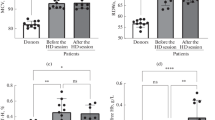Abstract
Although red cell morphology has been used to localise the site of haematuria in the urinary tract, the cause of red cell deformity is still speculative. We have conducted experiments in vitro using venous red cells which indicate that hypochromia depends mainly upon sodium concentration and occurs when this falls below 75 mmol/l. We simulated the passage of red cells through the renal tubule by sequentially treating them with fluids of composition similar to those in different tubular segments, and produced anisocytosis and hypochromia but not the typical “bizarre deformity” — the hallmark of glomerular haematuria. We conclude that dual injury is required to produce the “typical” dysmorphic red cells in glomerular haematuria. First, mechanical damage caused by passage of red blood cells through the glomerular basement membrane followed by a second, osmotic, injury sustained by red cells during passage through the hypotonic tubular segment.
Similar content being viewed by others
References
Birch DF, Fairley KF (1979) Haematuria: glomerular or non-glomerular? Lancet II: 845–846
Fairley KF, Birch DF (1982) Haematuria, a simple method for identifying glomerular bleeding. Kidney Int 21: 105–108
Fassett RG, Horgan B, Mathew TH (1982) Detection of glomerular bleeding by phase contrast microscopy. Lancet I: 1432–1434
Stapleton FB, Brown RE, Koh SJ (1983) Dysmorphic erythrocytes in children with haematuria: characterisation, recognition and diagnostic application (abstract). Pediatr Res 17:358A
Rizzoni G, Braggion F, Zacchello G (1983) Evaluation of glomerular and non-glomerular haematuria by phase-contrast microscopy. J Pediatr 103: 370–374
De Santo NG, Nuzzi F, Capodicasa G, Lama G, Caputo G, Rosati P, Giordano C (1987) Phase contrast microscopy of the urine sediment for the diagnosis of glomerular and non-glomerular bleeding — data in children and adults with normal creatinine clearance. Nephron 45: 35–39
Rath B, Turner C, Hartley B, Chantler C (1991) An evaluation of light microscopy to localise the site of haematuria. Arch Dis Child 66:338–340
Chang BS (1984) Red cell morphology as a diagnostic aid in haematuria. JAMA 252:1947–1949
Reusz GS, Tulassay R, Miltenyi M (1988) Differentiation of glomerular and non-glomerular haematuria. Lancet II: 50–51
Green PJ (1988) Differentiation of glomerular and non-glomerular haematuria. Lancet II: 51
Mouradian JA, Sherman RL (1975) Passage of an erythrocyte through a glomerular basement membrane gap. N Engl J Med 293: 940–941
Lin J-T, Wada H, Maeda H, Hattori M, Tanaka H, Uenoyama F, Suehiro A, Noguchi K, Nagai K (1983) Mechanism of haematuria in glomerular disease: an electron microscope study in a case of diffuse membranous glomerulonephritis. Nephron 35: 68–72
Stapleton FB (1987) Morphology of urinary red blood cells. Pediatr Clin North Am 34: 561–569
Bonventre JV, Lechene CP (1980) Renal medullary concentrating process: an integrative hypothesis. Am J Physiol 239: F578-F588
Fairley KF (1988) Urinalysis. In: Schrier RW, Gottschalk CW (eds) Diseases of the kidney. Little Brown, Boston. pp 359–391
Isegham P van, Hanglustaine D, Bollens W, Michielsen P (1983) Urinary erythrocyte morphology in acute glomerulonephritis. BMJ 287:1183
Author information
Authors and Affiliations
Rights and permissions
About this article
Cite this article
Rath, B., Turner, C., Hartley, B. et al. What makes red cells dysmorphic in glomerular haematuria?. Pediatr Nephrol 6, 424–427 (1992). https://doi.org/10.1007/BF00874000
Received:
Revised:
Accepted:
Issue Date:
DOI: https://doi.org/10.1007/BF00874000




